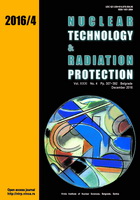
THERMAL BEHAVIOR ANALYSIS OF PWR FUEL DURING RIA AT VARIOUS FUEL BURNUPS USING MODIFIED THEATRe CODE

Vol.
XXXI, No. 4, Pp. 307-392
December 2016
UDC 621.039+614.876:504.06
ISSN 1451-3994
Pages: 307-317
Authors: Amjad Nawaz, Yoshikawa Hidekazu, Ming Yang, and Anwar HussainAbstract
The fuel irradiation and burnup causes geometrical and dimensional changes in the fuel rod which affects its thermal resistance and ultimately affects the fuel rod behavior during steady-state and transient conditions. The consistent analysis of fuel rod thermal performance is essential for precise evaluation of reactor safety in operational transients and accidents. In this work, analysis of PWR fuel rod thermal performance is carried out under steady-state and transient conditions at different fuel burnups. The analysis is performed by using thermal hydraulic code, THEATRe. The code is modified by adding burnup dependent fuel rod behavior models. The original code uses as-fabricated fuel rod dimensions during steady-state and transient conditions which can be modified to perform more consistent reactor safety analysis. AP1000 reactor is considered as a reference reactor for this analysis. The effect of burnup on steady-state fuel rod parameters has been investigated. For transient analysis, hypothetical reactivity initiated accident was simulated by considering a triangular power pulse of variable pulse height (relative to the full power reactor operating conditions) and pulse width at different fuel burnups which corresponds to fresh fuel, low and medium burnup fuels. The effect of power pulse height, pulse width and fuel burnup on fuel rod temperatures has been investigated. The results of reactivity initiated accident analysis show that the fuel failure mechanisms are different for fresh fuel and fuel at different burnup levels. The fuel failure in fresh fuel is expected due to fuel melting as fuel temperature increases with increase in pulse energy (pulse height). However, at relatively higher burnups, the fuel failure is expected due to cladding failure caused by strong pellet clad mechanical interaction, where, the contact pressure increases beyond the cladding yield strength.
Key words: reactivity initiated accidents, fuel rod thermal behavior, cladding deformation, AP1000, THEATRe code
FULL PAPER IN PDF FORMAT (1.27 MB)